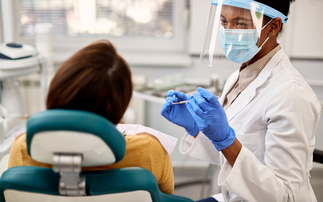Jennifer Wallis meets ergonomist and human factors consultant Stephen Bowden to discuss Emma, a life-sized model constructed to show the physical impact of workplaces
A hunched figure with a rotund stomach stands in the corner of the office. Her sallow skin is flaky, her ankles and wrists swollen and her bloodshot eyes stare ahead blankly. Sounds like a grisly character from a Roald Dahl book, but this is in fact a very real insight into what the modern workforce could look like in the not too distant future.
‘Emma' is a life-sized model constructed to show the adverse, and potentially irreversible, physical damage our everyday workspaces are inflicting upon our bodies.
She has been created in response to The Work Colleague of the Future Report, commissioned by Fellowes and written by behavioural futurist William Higham, which found that over 90% of office workers who suffer health issues as a result of a poor working environment say that their job has become more difficult. The modern office worker spends between seven and nine hours a days sat at their desk, and a poorly set up workspace leads to ailments such as strained eyes, headaches, muscular skeletal disorders and even type 2 diabetes.
“Modern technology has taken away the need to get up. And this is outside of work as well. It’s [part of] our Western culture.”Stephen Bowden, Ergonomist and human factor consultant
"To create change you really have to shock people into thinking ‘I don't want that to happen to me'," Stephen Bowden, the ergonomist and human factors consultant who was interviewed by Higham in conjunction with the report, tells COVER.
"Modern technology has taken away the need to get up," explains Bowden. "And this is outside of work as well. It's [part of] our Western culture. I've done a lot of work in Asia and at lunchtime all the workers are outside waving their arms about and stretching."
Space oddity
For inspiration, Bowden refers to the book Sitting Kills, Moving Heals written by the former director of NASA's life sciences division Dr Joan Vernikos. "Her job was to monitor the stress levels of astronauts. She found out that they weren't very stressed. They were very happy. One thing she did find out is that in space the body shows all of the signs of aging that we see on Earth but much, much faster [due to zero gravity]. One of the things they struggle with is the vestibular system. It spins out of control [without gravity]. It doesn't know where it is. The vestibular system is within the inner ear and is responsible for your balance. It turns off like a light switch in space after a period of time. When [the astronauts] come back to earth it doesn't turn back on straight away. They can't stand up."
According to Bowden, the sedentary lifestyle that we have become accustomed to today is leading to us age abnormally fast. We sit (if we're lucky) on the tube on the way to work, we sit at work, often eating lunch at our desks, when we get home after a long period of sitting we sit down on our sofas to watch TV. He continues: "When you're sitting still the vestibular system is not being stimulated against gravity so it shuts down, not as drastically as in space, but this will then affect your ability to regulate your blood pressure and another thing that drops off rapidly when you sit for extended periods of time is bone density [as well as] your cardiovascular system."
Today's modern world also has the added pressure of (or lack of) time. At work employees aim to cram in as much as possible for fear of not impressing their boss, not getting that promotion, not being able to pay rent. So even if workers do find themselves suffering some of Emma's symptoms, it is likely they will still head into the office regardless.
Nine till five
Health & Safety Executive stats from last year show that 6.9 million working days were lost due to work-related muscular skeletal disorders, 29% of all cases, while sick days are costing the UK £77.5bn a year (Britain's Healthiest Workplace survey 2017).
"You need to also take into account ‘presenteeism'," Bowden continues. "That's when you're coming to work when you're ill or [working with] any other distraction you have in the office. It's quite common to be able to hear someone else's conversation. Muscular skeletal disorders - so shoulder, neck discomfort - eye discomfort, repetitive strain… all of these elements add up and cause distraction and affect productivity."
Bowden agrees that employers have a responsibility to prevent their employees from suffering with such ailments but "sometimes it's seen as red tape".
"They don't see the benefits of it. If done correctly it can help improve productivity," he adds.
Get up, stand up
It's a legal requirement for companies with more than four employees to provide a display screen equipment (DSE) assessment. This, plus good office ergonomic equipment are a good place to start to help prevent us all resembling Emma in 20 years time.
"It hasn't got to be complicated," Bowden tells us. "If you can have a sit-stand desk as standard, fantastic. If you can't, there are stands and adaptors that go on the desk."
Is standing then solution then? "The people who are at risk," Bowden explains "are the people who sit down for excessive hours. The people who are fidgeting and moving around already, they're not my concern. The people who sit for excessive hours, they need to have their way of thinking changed. Sit stand devices are fantastic for those guys but standing still isn't the solution. The [effect] on the body is very similar to sitting still. It's getting up that's the key. It's the stimulus against gravity that's fundamental."
Just keep movin'
Bowden also points out that office culture itself needs to change. Offices need to create separate spaces for people to go to; a separate area for meetings and a space for people to go to enjoy their lunch.
"If you can provide spaces in your workplace for different tasks then people have to get up to do their job," he explains. "You need to make movement part of the job."
In order to maintain a healthy muscular and cardiovascular system, research has shown that we need to move between 33-36 times a day. In an interview in The Guardian earlier this year, Dr James Levine of the Mayo Clinic, echoed Bowden, saying that: "The real solution is to move. All day. The stillness is what's killing us."
Stairway to heaven
Architects also have a big responsibility when designing the offices of the future by incorporating different levels. Bowden says stairs should be the first thing you see when you walk into the building and they should be stairs that look inviting and make you want to take them rather than standing on an escalator. "Getting people moving [is key]," Stephen continues. "If you want to reduce all the things listed in the report; muscular skeletal disorders and a number of chronic diseases type 2 diabetes, cardiovascular disease. Getting simple everyday movements is what we need to achieve. It's quite simple really but it's hard to get people changing their behaviour because of modern technology."
The solution to preventing these ailments and to avoid becoming a nation of disfigured, hunchbacks is pretty simple. HR departments must arrange a DSE assessment and make small changes to encourage staff to use stairs (where appropriate) and get up from their desk every half an hour.
Chasing waterfalls
One way to do this is to suggest not keeping bottles of water on desks, Bowden advises.
"Every half an hour you're going to have to stand up and have a drink," says Bowden. "What most people say to that is: ‘I'm too busy'. Einstein talked about the distraction index. His record for concentration was 42 minutes, but for most people in an open plan office on average it's about 12 minutes so we have no excuse to not stand up and have a break from working on your computer. Get up every half an hour. You should see your symptoms of backache neck ache all starting to reduce, as well as if you have a good set-up."










